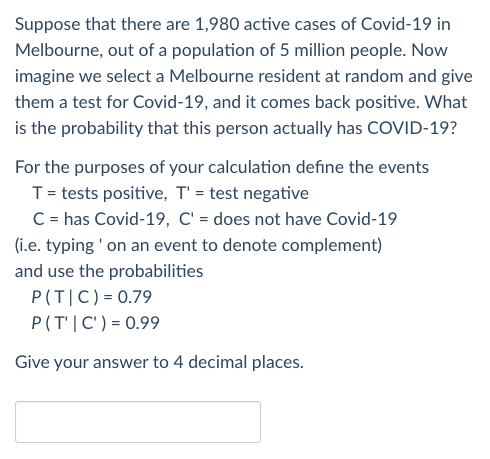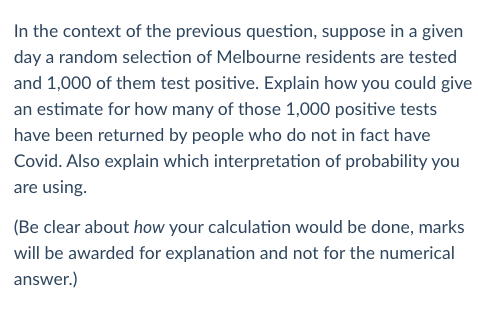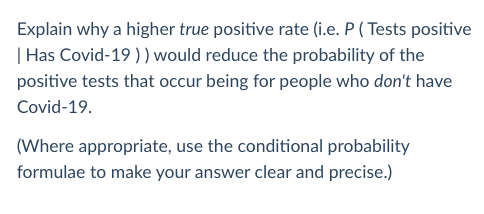


Suppose that there are 1,980 active cases of Covid-19 in Melbourne, out of a population of 5 million people. Now imagine we select a Melbourne resident at random and give them a test for Covid-19, and it comes back positive. What is the probability that this person actually has OVID-19? For the purposes of your calculation define the events T = tests positive, T' = test negative C = has Covid-19, C' = does not have Covid-19 (i.e. typing' on an event to denote complement) and use the probabilities P(TIC) = 0.79 P(T'C') = 0.99 Give your answer to 4 decimal places. In the context of the previous question, suppose in a given day a random selection of Melbourne residents are tested and 1,000 of them test positive. Explain how you could give an estimate for how many of those 1,000 positive tests have been returned by people who do not in fact have Covid. Also explain which interpretation of probability you are using. (Be clear about how your calculation would be done, marks will be awarded for explanation and not for the numerical answer.) Explain why a higher true positive rate (i.e. P (Tests positive | Has Covid-19 ) ) would reduce the probability of the positive tests that occur being for people who don't have Covid-19. (Where appropriate, use the conditional probability formulae to make your answer clear and precise.) Suppose that there are 1,980 active cases of Covid-19 in Melbourne, out of a population of 5 million people. Now imagine we select a Melbourne resident at random and give them a test for Covid-19, and it comes back positive. What is the probability that this person actually has OVID-19? For the purposes of your calculation define the events T = tests positive, T' = test negative C = has Covid-19, C' = does not have Covid-19 (i.e. typing' on an event to denote complement) and use the probabilities P(TIC) = 0.79 P(T'C') = 0.99 Give your answer to 4 decimal places. In the context of the previous question, suppose in a given day a random selection of Melbourne residents are tested and 1,000 of them test positive. Explain how you could give an estimate for how many of those 1,000 positive tests have been returned by people who do not in fact have Covid. Also explain which interpretation of probability you are using. (Be clear about how your calculation would be done, marks will be awarded for explanation and not for the numerical answer.) Explain why a higher true positive rate (i.e. P (Tests positive | Has Covid-19 ) ) would reduce the probability of the positive tests that occur being for people who don't have Covid-19. (Where appropriate, use the conditional probability formulae to make your answer clear and precise.)









